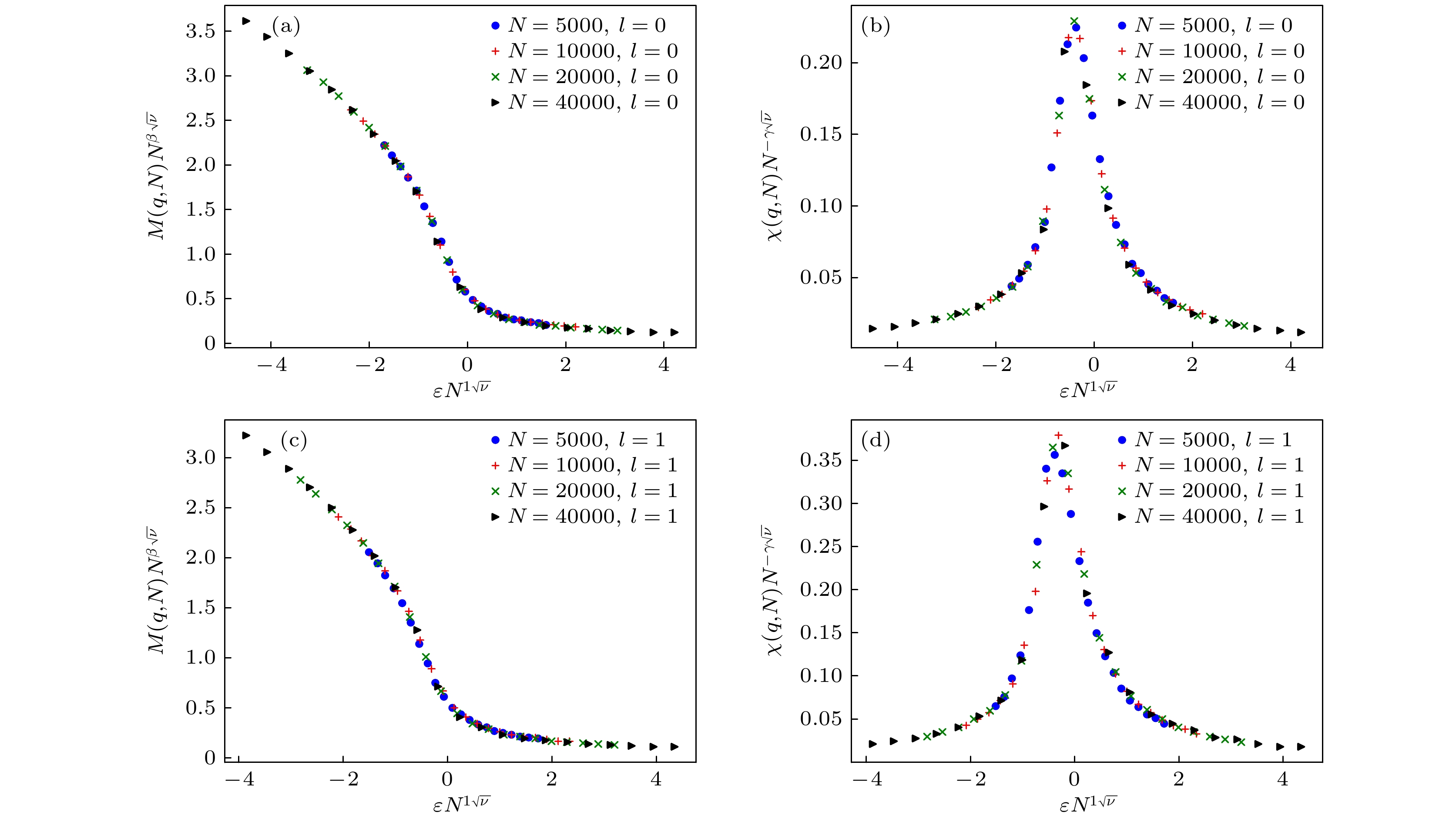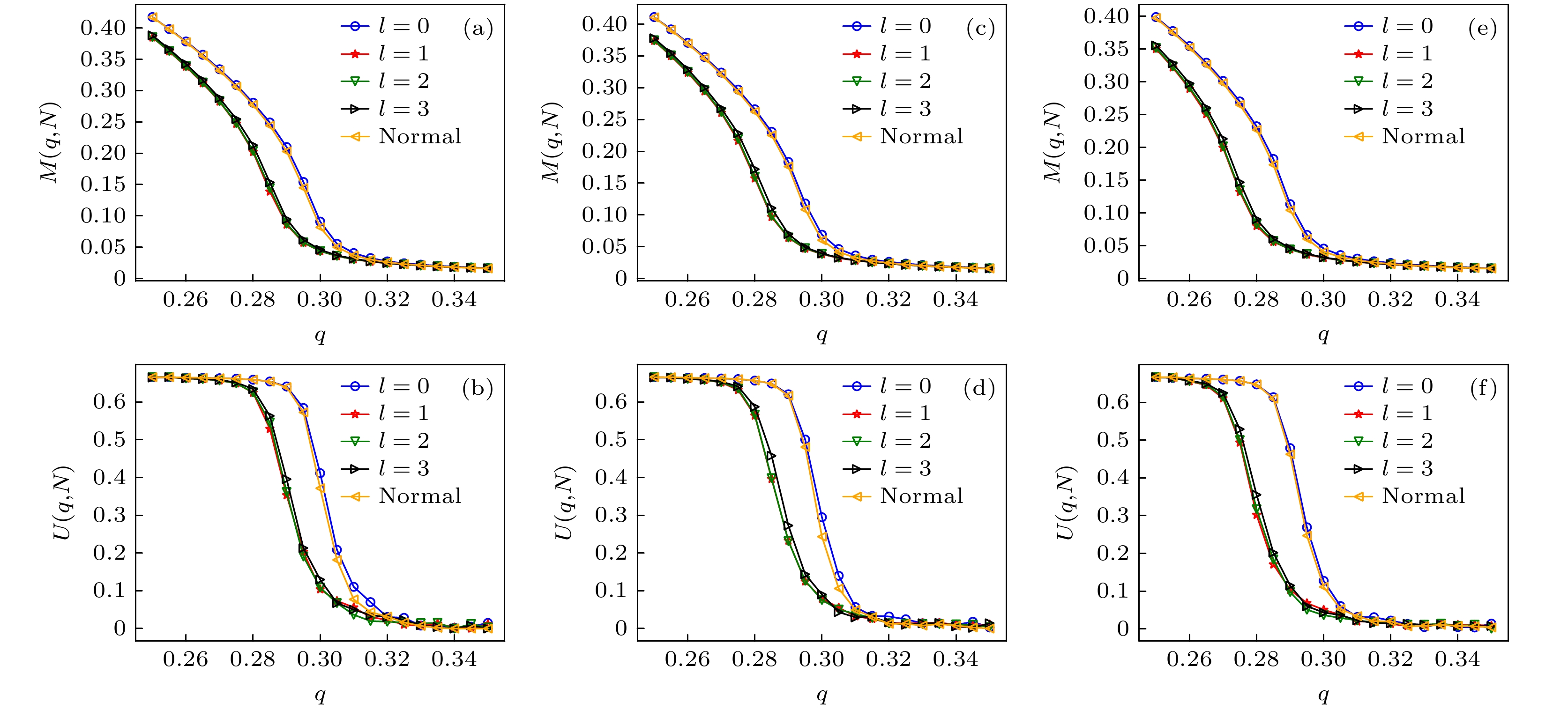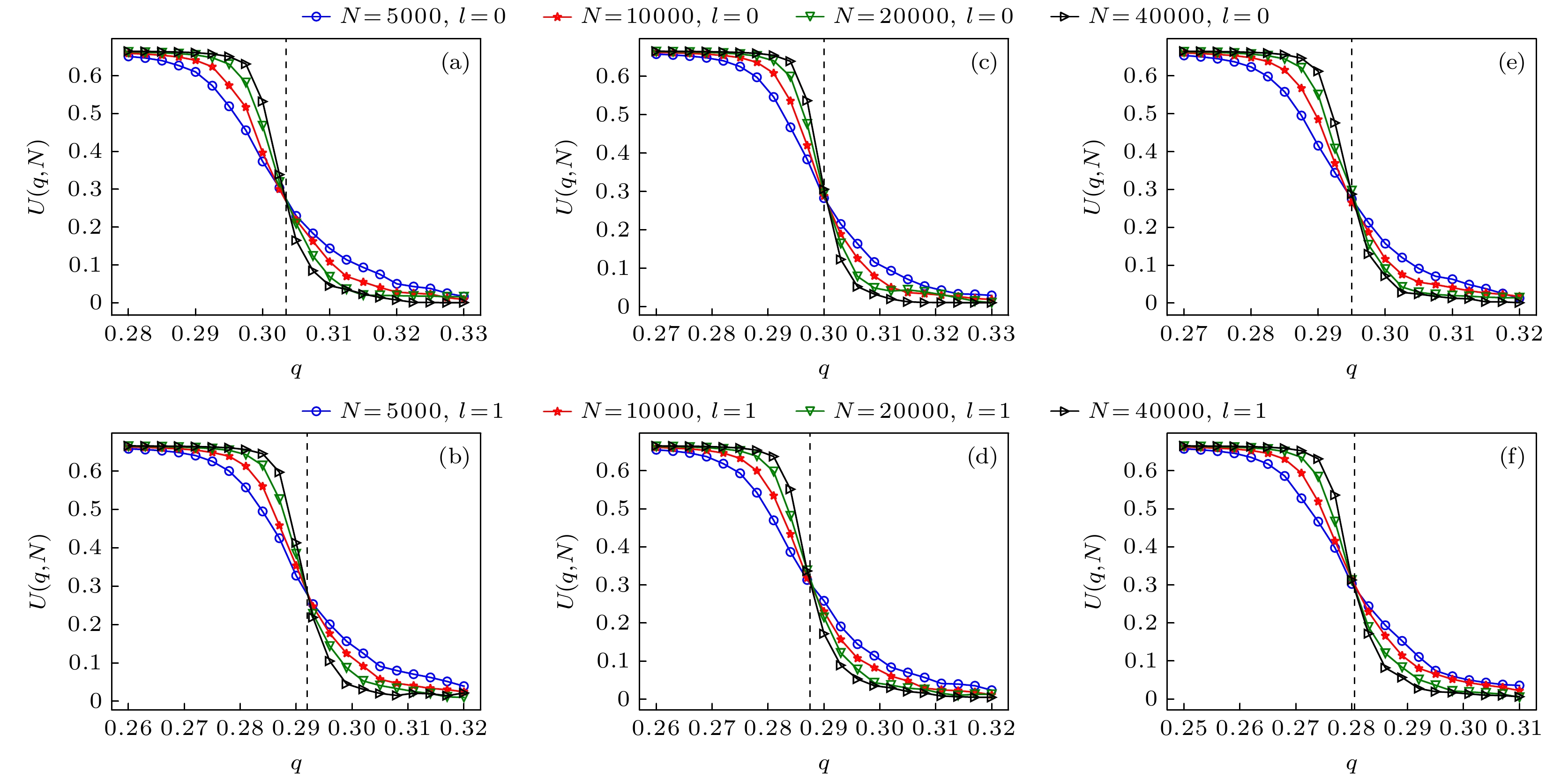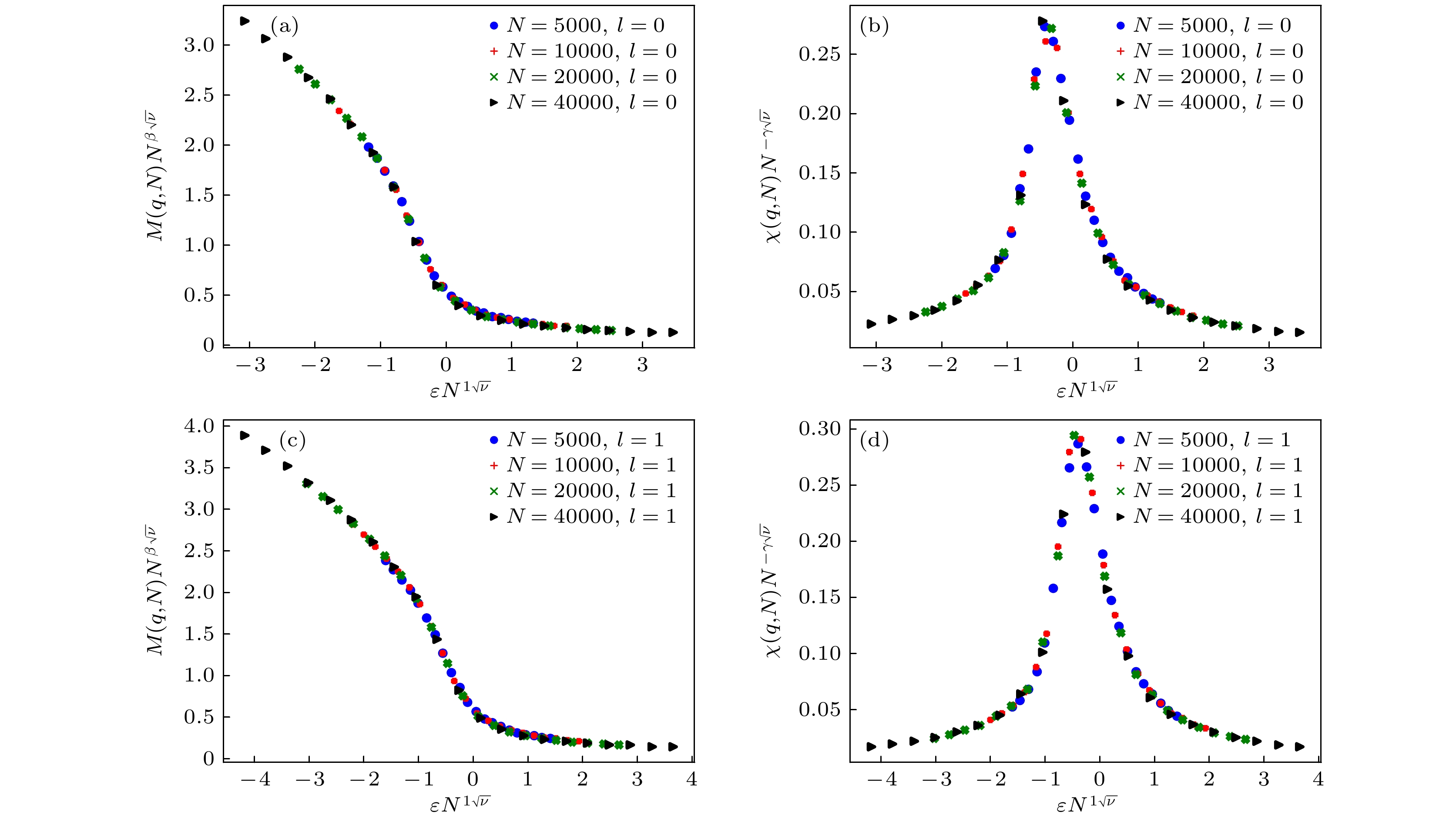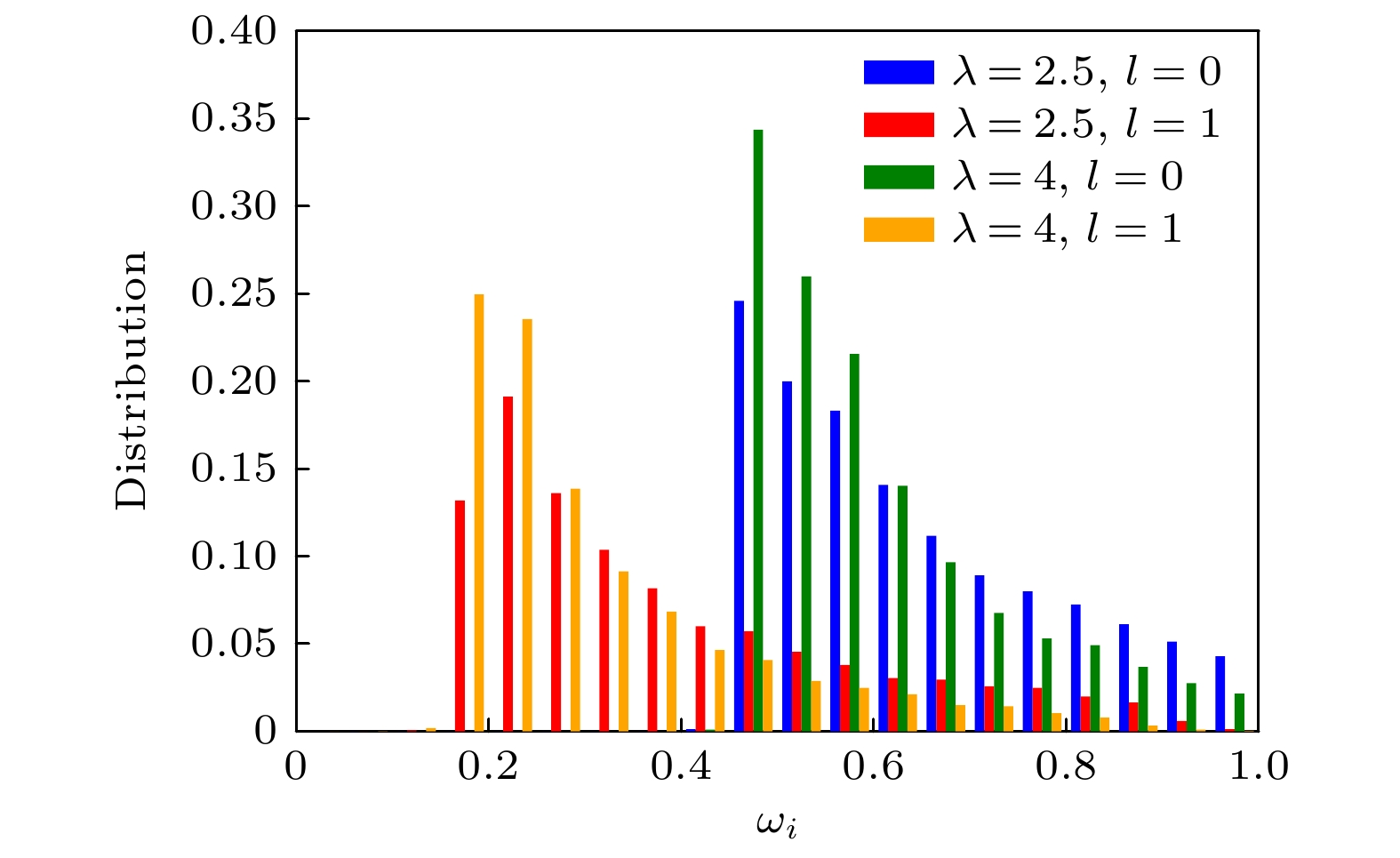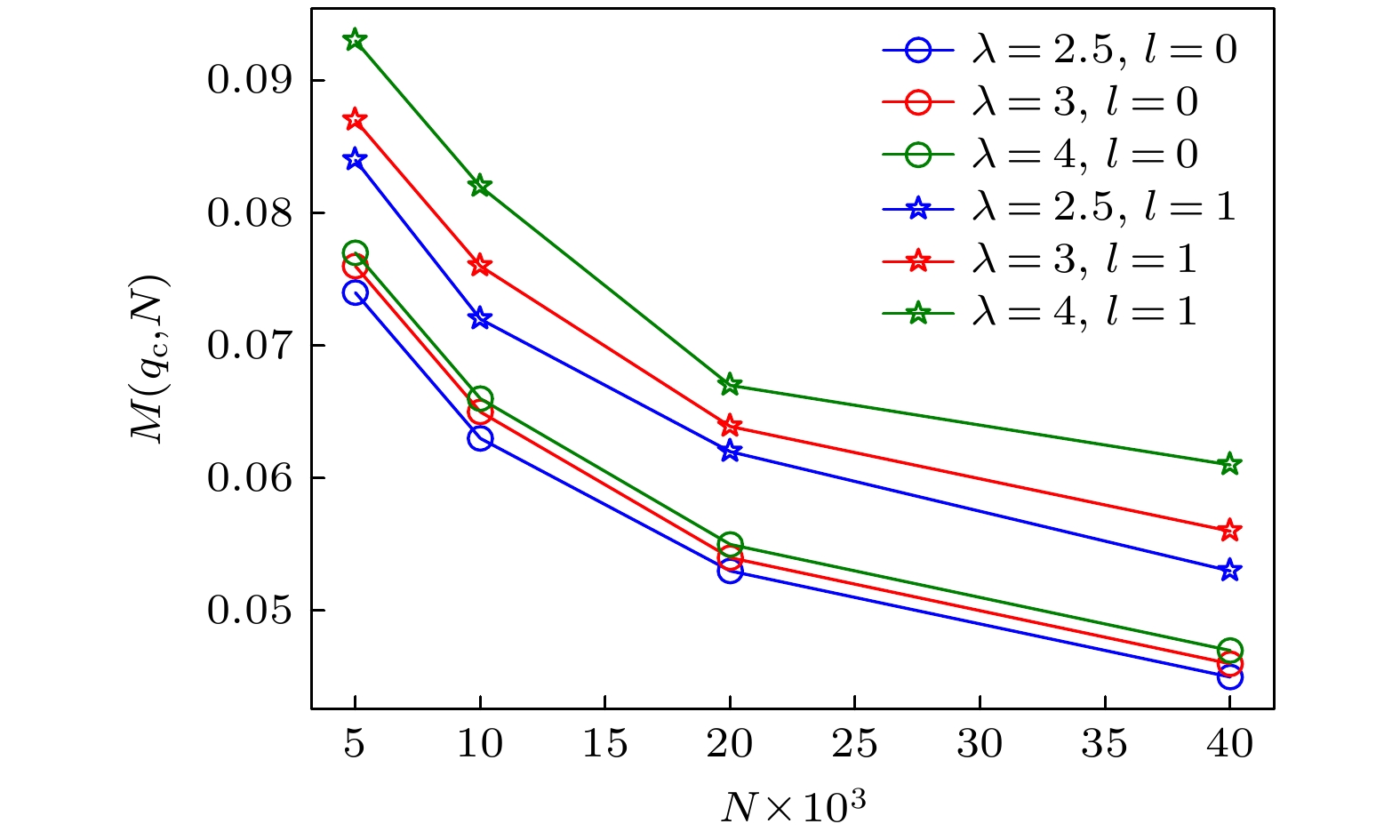-
Majority-vote model is a commonly used model in the study of opinion dynamics. In the original majority-vote model, the influence of node is determined by their neighbors. But there are nodes with low degree surrounded by nodes with high degree so they also have a great influence on the evolution of opinions. Therefore, the influence of a node should not only be measured by neighbors but also be connected to itself directly. Thus, this paper adds collective influence with hierarchical structures into the majority-vote model and measures opinion weight of center node by degree of their neighbors on hierarchical structures surround it with the set distance. The collective influence parameters used in this paper are related to the value of collective influence mentioned above and normalized by the maximum value of all nodes in system. The opinions’ evolution of majority-vote model with collective influence is studied in ER random networks and scale-free networks with different degree distribution exponents by Monte Carlo simulations. It is found that all systems have order-to-disorder phase transitions with the increase of noise parameter. When the depth of hierarchical structure is not zero, the system with collective influence is much easier to turn to disordered states so their critical noise parameters of phase transition are smaller than those of 0-depth systems and original majority-vote model. The reason is that high degree nodes in original majority-vote model have high influence because they are connected to more neighbors and nodes’ influence is also directly determined by degree in 0-depth collective influence model. Furthermore, nodes’ collective influence parameters in the system will all decrease when hierarchical structure of nonzero depth is considered, only a small number of individuals have high influence parameters in the system and they will make the opinions of surrounding individuals follow theirs, so if the opinions of a few highly influential individuals are out of order, then the system will reach a state of disorder. Because of the above factors, the collective influence model of nonzero depth is much easier to disorder with the increase of noise parameter. Besides, the system proves to be easier to reach a disordered state with the increase of degree distribution exponents in scale-free networks because all nodes’ degree will be lower so that the system will be dominated by less nodes with high degree. This conclusion verifies that scale-free networks are more similar to ER random networks with the increase of degree distribution exponents. Finally, through the finite-size scaling method, it is found that the phase transition of the majority-vote model with collective influence of hierarchical structures belongs in the Ising model universal class, whether in ER random networks or in scale-free networks.
-
Keywords:
- majority-vote model /
- collective influence /
- complex networks /
- phase transition
[1] Calvelli M, Crokidakis N, Penna T J P 2019 Physica A 513 518
 Google Scholar
Google Scholar
[2] Pires M A, Crokidakis N 2022 Phil. Trans. R. Soc. A. 380 20210164
 Google Scholar
Google Scholar
[3] Khalil N, Galla T 2021 Phys. Rev. E 103 012311
 Google Scholar
Google Scholar
[4] Liu J Z, Huang S D, Aden N M, Johnson N F, Song C M 2023 Phys. Rev. Lett. 130 037401
 Google Scholar
Google Scholar
[5] Costa L S A, de Souza A J F 2005 Phys. Rev. E 71 056124
 Google Scholar
Google Scholar
[6] Lima F W S, Fulco U L, Costa Filho R N 2005 Phys. Rev. E 71 036105
 Google Scholar
Google Scholar
[7] de Oliveira M J 1992 J. Stat. Phys. 66 273
 Google Scholar
Google Scholar
[8] Mendes J F F, Santos M A 1998 Phys. Rev. E 57 108
 Google Scholar
Google Scholar
[9] de Silva Hilho A G, Moreira F G B 2002 J. Stat. Phys. 106 391
 Google Scholar
Google Scholar
[10] Campos P R A, de Oliveira V M, Brady Moreira F G 2003 Phys. Rev. E 67 026104
 Google Scholar
Google Scholar
[11] Pereira L F C, Moreira F G B 2005 Phys. Rev. E 71 016123
 Google Scholar
Google Scholar
[12] Kwak W, Yang J S, Sohn J I, et al. 2007 Phys. Rev. E 75 061110
 Google Scholar
Google Scholar
[13] de Oliveira M J, Mendes J F F, Santos M A 1993 J. Phys. A 26 2317
 Google Scholar
Google Scholar
[14] Marques M C 1993 J. Phys. A 26 1559
 Google Scholar
Google Scholar
[15] Pastor-Satorras R, Vespignani A 2001 Phys. Rev. Lett. 86 3200
 Google Scholar
Google Scholar
[16] Lloyd A L, May R M 2001 Science 292 1316
 Google Scholar
Google Scholar
[17] Wang S J, Wu Z X, Dong H R, Chen G R 2010 Int. J. Mod. Phys. C 21 67
 Google Scholar
Google Scholar
[18] Morone F, Makse H A 2015 Nature 524 65
 Google Scholar
Google Scholar
[19] Binder K 1981 Physica B 43 119
 Google Scholar
Google Scholar
[20] 普利施克 M, 贝格森 B著(汤雷翰, 童培庆译)2020 平衡态统计物理学(北京: 北京大学出版社)第174—177页
Plischke M, Bergersen B (translated by Tang L H, Tong P Q) 2020 Equilibrium Statistical Physics (Beijing: Peking University Press) pp174–177
[21] Molloy M, Reed B 1995 Random Struct. Algorithms 6 161
 Google Scholar
Google Scholar
[22] Molloy M, Reed B 1998 Comb. Probab. Comput. 7 295
 Google Scholar
Google Scholar
[23] Lima F W S 2006 Int. J. Mod. Phys. C 17 1257
 Google Scholar
Google Scholar
[24] Kim M, Yook S H 2021 Phys. Rev. E 103 022302
 Google Scholar
Google Scholar
-
图 1 (a), (b)分别表示在 ER 随机网络中磁化强度$ M(q, N) $、四阶宾德累积矩$ U(q, N) $随噪声参数$ q $的变化曲线, 网络平均度$ \left\langle{k}\right\rangle=10 $, 节点数$ N=10000 $
Figure 1. (a), (b) The variation curves of magnetization $ M(q, N) $ and Binder’s fourth-order cumulant $ U(q, N) $ with noise parameter $ q $ in ER random network, respectively. The average degree of networks is $ \left\langle{k}\right\rangle=10 $, and the number of nodes is $ N=10000 $.
图 2 (a), (b)在 ER 网络中, 当$ l=0 $和$ l=1 $时四阶宾德累积矩$ U(q, N) $随噪声参数$ q $的变化曲线. 网络平均度$ \left\langle{k}\right\rangle=10 $
Figure 2. (a), (b) $ l=0 $ and $ l=1 $ of the Binder’s fourth-order cumulant $ U(q, N) $ with noise parameter $ q $ in the ER network, respectively. The average degree of networks is $ \left\langle{k}\right\rangle=10 $.
图 4 (a), (b) 分别为ER网络在$ l=0 $时磁化强度$ M(q, N) $与磁化率$ \chi (q, N) $的有限尺寸标度图; (c), (d)分别为ER网络在$ l=1 $时磁化强度$ M(q, N) $与磁化率$ \chi (q, N) $的有限尺寸标度图
Figure 4. (a), (b) The finite size scaling graphs of the magnetization $ M(q, N) $ and the susceptibility $ \chi (q, N) $ of the ER network at $ l=0 $, respectively; (c), (d) the finite size scaling graphs of the magnetization $ M(q, N) $ and the susceptibility $ \chi (q, N) $ of the ER network at $ l= 1 $, respectively.
图 5 (a), (b) $ \lambda =2.5 $; (c), (d) $ \lambda =3 $; (e), (f) $ \lambda =4 $无标度网络中磁化强度$ M(q, N) $、四阶宾德累积矩$ U(q, N) $随噪声参数$ q $的变化曲线. 网络平均度$ \left\langle{k}\right\rangle=10 $, 节点数$ N=10000 $
Figure 5. The variation curves of magnetization $ M(q, N) $ and Binder’s fourth-order cumulant $ U(q, N) $ with noise parameter $ q $ in scale-free networks with (a), (b) $ \lambda =2.5 $; (c), (d) $ \lambda =3 $; (e), (f) $ \lambda =4 $, respectively. The average degree of networks is $ \left\langle{k}\right\rangle=10 $, and the number of nodes is $ N=10000 $.
图 6 (a), (b) $ \lambda =2.5 $; (c), (d) $ \lambda =3 $; (e), (f) $ \lambda =4 $无标度网络中$ l=0 $和$ l=1 $时四阶宾德累积矩$ U(q, N) $随噪声参数$ q $的变化曲线. 网络平均度$ \left\langle{k}\right\rangle=10 $
Figure 6. The variation curves of the Binder’s fourth-order cumulant $ U(q, N) $ with the noise parameter q when $ l=0 $ and $ l=1 $ in a scale-free network with (a), (b) $ \lambda =2.5 $; (c), (d) $ \lambda =3 $; (e), (f) $ \lambda =4 $, respectively. The average degree of networks is $ \left\langle{k}\right\rangle=10 $.
图 8 $ l=0 $和$ l=1 $的具有集体影响力的多数投票模型中, 无标度网络不同度分布指数$ \lambda $对应的相变临界点$ {q}_{{\mathrm{c}}} $
Figure 8. In the majority-vote model with collective influence of $ l=0 $ and $ l=1 $, the phase transition critical point $ {q}_{{\mathrm{c}}} $ with different degree distribution index $ \lambda $ of the scale-free network.
图 9 $ N=10000 $, $ \lambda =2.5 $的无标度网络中 (a) $ {\omega }_{i} $的分布情况; (b)不同度$ {k}_{i} $的$ {\omega }_{i} $平均值统计情况
Figure 9. In scale-free network when $ N=10000 $ and $ \lambda =2.5 $: (a) Distribution of $ {\omega }_{i} $ in scale-free networks; (b) the statistics of the average value of $ {\omega }_{i} $ of different degrees $ {k}_{i} $ .
表 1 $ {\omega }_{i} $均值和方差
Table 1. Mean and variance of $ {\omega }_{i} $.
$ l=0 $ $ l=1 $ $ l=2 $ $ l=3 $ $ \left\langle{{\omega }_{i}}\right\rangle $ $ 0.41\left(6\right) $ $ 0.18\left(5\right) $ $ 0.18\left(3\right) $ $ 0.19\left(3\right) $ $ \sigma \left({\omega }_{i}\right) $ $ 0.017\left(4\right) $ $ 0.014\left(9\right) $ $ 0.014\left(5\right) $ $ 0.014\left(9\right) $ 表 2 不同网络对应的$ {q}_{{\mathrm{c}}0} $, $ {q}_{{\mathrm{c}}1} $以及$ |{q}_{{\mathrm{c}}0}-{q}_{{\mathrm{c}}1}| $
Table 2. $ {q}_{{\mathrm{c}}0} $, $ {q}_{{\mathrm{c}}1} $ and $ |{q}_{{\mathrm{c}}0}-{q}_{{\mathrm{c}}1}| $ of different networks.
ER网络 $ \lambda =2.5 $ $ \lambda =2.7 $ $ \lambda =3 $ $ \lambda =3.5 $ $ \lambda =4 $ $ {q}_{{\mathrm{c}}0} $ 0.301 0.3035 0.3015 0.3 0.297 0.295 $ {q}_{{\mathrm{c}}1} $ 0.283 0.292 0.2895 0.2875 0.2835 0.2805 $ |{q}_{{\mathrm{c}}0}-{q}_{{\mathrm{c}}1}| $ 0.018 0.0115 0.012 0.0125 0.0135 0.0145 表 3 $ {\omega }_{i} $均值和方差
Table 3. Mean and variance of $ {\omega }_{i} $.
$ l=0 $ $ l=1 $ $ l=2 $ $ l=3 $ $ \left\langle{{\omega }_{i}}\right\rangle $ 0.66(2) 0.37(6) 0.36(9) 0.38(1) $ \sigma \left({\omega }_{i}\right) $ 0.22(4) 0.035(2) 0.033(8) 0.033(8) 表 4 $ {\omega }_{i} $均值和方差
Table 4. Mean and variance of $ {\omega }_{i} $.
$ l=0 $ $ l=1 $ $ l=2 $ $ l=3 $ $ \left\langle{{\omega }_{i}}\right\rangle $ $ \lambda =2.5 $ 0.66(2) 0.37(6) 0.36(9) 0.38(1) $ \lambda =4 $ 0.61(7) 0.33(6) 0.33(7) 0.34(6) $ \sigma \left({\omega }_{i}\right) $ $ \lambda =2.5 $ 0.022(5) 0.035(2) 0.033(8) 0.033(8) $ \lambda =4 $ 0.017(4) 0.027(4) 0.027(5) 0.027(4) 表 5 临界指数实验结果与引用数据对照
Table 5. Results of critical exponents and reference data for comparison.
$ l=0 $ ER网络 $ \lambda =2.5 $ $ \lambda =3 $ $ \lambda =4 $ $ 1/\bar{\nu } $ 0.49(6) 0.45(5) 0.46(1) 0.48(5) $ \beta /\bar{\nu } $ 0.23(5) 0.23(1) 0.23(5) 0.23(5) $ \gamma /\bar{\nu } $ 0.49(5) 0.49(2) 0.49(2) 0.49(5) $ l=1 $ ER网络 $ \lambda =2.5 $ $ \lambda =3 $ $ \lambda =4 $ $ 1/\bar{\nu } $ 0.47(5) 0.44(6) 0.46(5) 0.47(5) $ \beta /\bar{\nu } $ 0.23(6) 0.22(1) 0.23(1) 0.23(5) $ \gamma /\bar{\nu } $ 0.50(5) 0.51(5) 0.51(5) 0.51(2) 原始多数投票模型 ER网络 $ \lambda < 3 ~ (\lambda =2.7) $ $ 3 < \lambda < 5 ~ (\lambda =3.7) $ $ \lambda > 5~ (\lambda =5.2) $ $ 1/\bar{\nu } $ $ 0.5 $ $ 0.31 $ $ 0.48 $ $ 0.47 $ $ \beta /\bar{\nu } $ $ 0.25 $ $ 0.25 $ $ 0.25 $ $ 0.21 $ $ \gamma /\bar{\nu } $ $ 0.5 $ $ 0.51 $ $ 0.49 $ $ 0.57 $ -
[1] Calvelli M, Crokidakis N, Penna T J P 2019 Physica A 513 518
 Google Scholar
Google Scholar
[2] Pires M A, Crokidakis N 2022 Phil. Trans. R. Soc. A. 380 20210164
 Google Scholar
Google Scholar
[3] Khalil N, Galla T 2021 Phys. Rev. E 103 012311
 Google Scholar
Google Scholar
[4] Liu J Z, Huang S D, Aden N M, Johnson N F, Song C M 2023 Phys. Rev. Lett. 130 037401
 Google Scholar
Google Scholar
[5] Costa L S A, de Souza A J F 2005 Phys. Rev. E 71 056124
 Google Scholar
Google Scholar
[6] Lima F W S, Fulco U L, Costa Filho R N 2005 Phys. Rev. E 71 036105
 Google Scholar
Google Scholar
[7] de Oliveira M J 1992 J. Stat. Phys. 66 273
 Google Scholar
Google Scholar
[8] Mendes J F F, Santos M A 1998 Phys. Rev. E 57 108
 Google Scholar
Google Scholar
[9] de Silva Hilho A G, Moreira F G B 2002 J. Stat. Phys. 106 391
 Google Scholar
Google Scholar
[10] Campos P R A, de Oliveira V M, Brady Moreira F G 2003 Phys. Rev. E 67 026104
 Google Scholar
Google Scholar
[11] Pereira L F C, Moreira F G B 2005 Phys. Rev. E 71 016123
 Google Scholar
Google Scholar
[12] Kwak W, Yang J S, Sohn J I, et al. 2007 Phys. Rev. E 75 061110
 Google Scholar
Google Scholar
[13] de Oliveira M J, Mendes J F F, Santos M A 1993 J. Phys. A 26 2317
 Google Scholar
Google Scholar
[14] Marques M C 1993 J. Phys. A 26 1559
 Google Scholar
Google Scholar
[15] Pastor-Satorras R, Vespignani A 2001 Phys. Rev. Lett. 86 3200
 Google Scholar
Google Scholar
[16] Lloyd A L, May R M 2001 Science 292 1316
 Google Scholar
Google Scholar
[17] Wang S J, Wu Z X, Dong H R, Chen G R 2010 Int. J. Mod. Phys. C 21 67
 Google Scholar
Google Scholar
[18] Morone F, Makse H A 2015 Nature 524 65
 Google Scholar
Google Scholar
[19] Binder K 1981 Physica B 43 119
 Google Scholar
Google Scholar
[20] 普利施克 M, 贝格森 B著(汤雷翰, 童培庆译)2020 平衡态统计物理学(北京: 北京大学出版社)第174—177页
Plischke M, Bergersen B (translated by Tang L H, Tong P Q) 2020 Equilibrium Statistical Physics (Beijing: Peking University Press) pp174–177
[21] Molloy M, Reed B 1995 Random Struct. Algorithms 6 161
 Google Scholar
Google Scholar
[22] Molloy M, Reed B 1998 Comb. Probab. Comput. 7 295
 Google Scholar
Google Scholar
[23] Lima F W S 2006 Int. J. Mod. Phys. C 17 1257
 Google Scholar
Google Scholar
[24] Kim M, Yook S H 2021 Phys. Rev. E 103 022302
 Google Scholar
Google Scholar
Catalog
Metrics
- Abstract views: 1040
- PDF Downloads: 47
- Cited By: 0















 DownLoad:
DownLoad:


